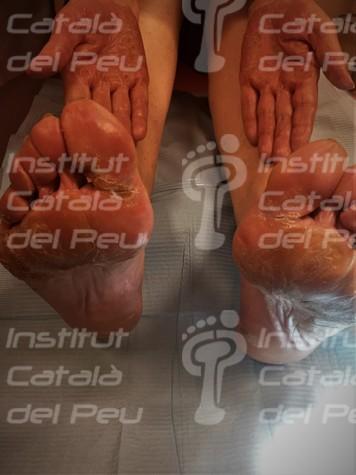The palmoplantar keratodermas are a diverse set of cutaneous diseases. The main feature is the appearance of hyperkeratosic lesions like a kind of yellow and hard papule located on the palmae of hands and planta pedis.
The hereditary palmoplantar keratodermas appear on early ages and they are related to very well described syndromes, while acquired palmoplantar keratodermas appear during the adulthood, with no backgrounds and they are related to a clearly-defined cause (AIDS, lichen planus, psoriasis, arsenical keratosis, etc.).
There are three kinds of palmoplantar keratodermas:
- Diffused: It is a palmoplantar keratoderma which appear in the first months of life and its main feature is the appearance of a thick and symmetrical layer in the palm and the planta pedis. It is a predominant autosomal disorder and it is classified in:
- Epidermolytical diffused palmoplantar keratoderma or Vörner’s keratoderma. It is one of the most common. The main feature is that it has the appearance of a snake’s skin.
- Non epidermolytical diffused palmoplantar keratoderma or Unna-Thost keratoderma. It has a waxy appearance.
- Focal: the focal palmoplantar keratoderma has keratin compact masses in continuous pressure zones with a discoid (circular) or linear shape (striated).
- Punctate: the palmoplantar keratoderma shows small keratoses like drops of water on palms and planta pedis. There are three types:
- The punctate keratosis in palms and planta pedis is a predominant autosomal palmoplantar keratoderma with genetic existence and it has many and small keratosis which start on the lateral rim of fingers and toes.
- The spinous keratoderma is a predominant autosomal keratoderma. It has a late appearance. Its main feature are many keratosic spots.
- Focal acral hyperkeratosis. It is a late keratoderma because of a predominant autosomal condition characterized by papules with a crater shape.
There are also another unclassified palmoplantar keratodermas like the next ones:
- The palmoplantar keratoderma and the spastic paraplegia. It starts during childhood with a thick focal keratoderma with more impact on planta pedis than palms.
- The striated palmoplantar keratoderma is a predominant autosomal keratoderma and it starts during childhood.
- Sybert’s palmoplantar keratoderma is a predominant autosomal disease which affects palms and planta pedis in a symmetric way and a distribution of gloves and panty hose.
- Carvajal’s syndrome. It is an autosomal, hereditary, dermic and recessive disease.
- Olmsted’s syndrome. It is a palmoplantar keratoderma with deformities in the flexion of fingers and toes.
- Vohwinkel’s syndrome. It is a diffused predominant autosomal palmoplantar keratoderma which appears on early ages in a honeycomb shape.
- Huriez’s scleroatrophyc syndrome. It is a predominant autosomal keratoderma with sclerodactylia from birth and also with palmoplantar diffused symmetric keratoderma.
A lot of pharmacological treatments are symptomatic and make use of keratolytic agents associated to oral retinoids. These are the most common treatments:
- Vitamin A.
- Vitamin D.
- Heparin.
- Botulinus toxin.
- Pyrimidine.
- Keratolytic agents.
The treatments of palmoplantar keratodermas reduce the symptomatology. However, there is no standard treatment.
